Portrait Yaroslav Romanyuk
Thin layers, high goals
Yaroslav Romanyuk has been working at Empa for around 15 years on complex thin-film technologies for solar cells, printed circuits, novel solid-state batteries and other applications. Since the beginning of July, he is heading the Laboratory for Thin Films and Photovoltaics and is pursuing ambitious goals with his team – from innovative materials to founding a start-up and using artificial intelligence for future experiments.
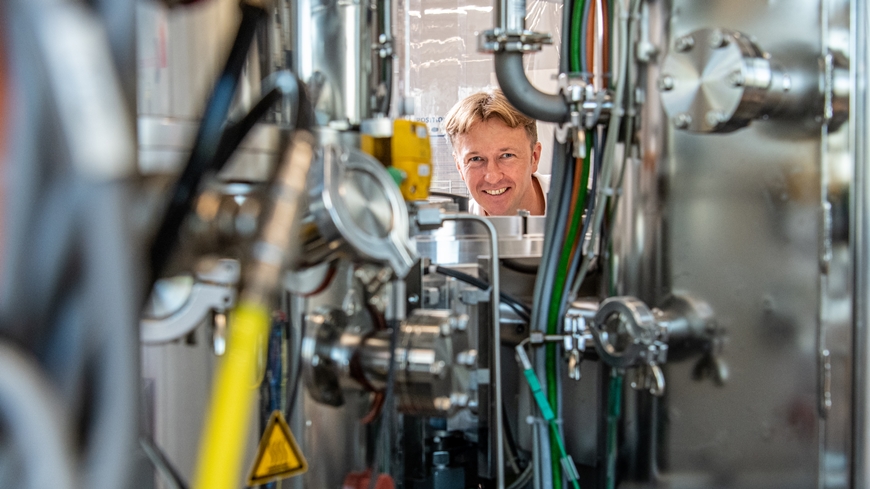
He could have lived in Germany, in the US, in Poland perhaps, or at home in Ukraine. But then Yaroslav Romanyuk had his postcard moment. In 2002, he traveled to Lausanne for an interview for a doctorate at EPFL: from Luzk in Ukraine by bus via Poland to Zurich; from there on the train to Lausanne, into the tunnel behind Puidoux – and out into the enchanting vista over the vineyards to Lac Léman. That picturesque place, of which the vernacular says that the German-speaking Swiss tear their return tickets and throw them out of the window.
And so it became Switzerland. Romanyuk's Empa career began in Zurich in 2008, when he moved to Empa from Zurich's Technopark with the now retired lab head Ayodhya Tiwari and his solar cell research group. The chemist shares valuable experience and successes with his former boss, such as several world records in the efficiency of flexible thin-film solar cells, a dozen successful jointly supervised doctoral theses and much more. "Together, we have opened up new fields of research we would never have dreamt of in the beginning!" says Romanyuk.
That's how it should continue: big goals with thin films and novel combinations of materials that have fascinated him since he started doing research. For instance, as a postdoc at the University of California at Berkeley, where he worked on semiconductors made of gallium nitride and similar combinations, doped with rare earths – for light emissions, i.e. optical applications or future lasers. In the end, though, it didn't work. "The obstacles were stronger than me … unfortunately," Romanyuk admits bluntly, "It was a really ambitious idea, though. And I really wanted to try something new at that time."
The joy of working with talents
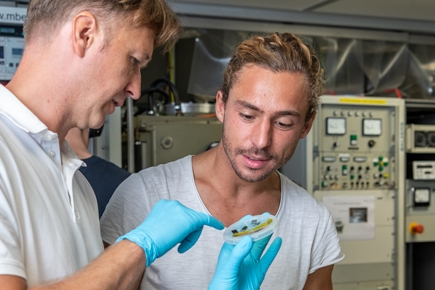
But the proof of the pudding is in the eating. This holds true also for his current research fields. In addition to very targeted projects with his collaborators, such as novel solid-state batteries produced by physical vapor deposition, or printed electronics using digital printing processes, some results also came about unexpectedly, for example transparent security films for invisible "locks". Not everything can be planned, Romanyuk says: "Some discoveries just happen; suddenly and surprisingly, when teams work together with a lot of enthusiasm."
He has mentored and nurtured many talents, with great pleasure, more than 40 diploma and doctoral theses. And numerous graduates, the new lab head recalls, are now working in leading positions at renowned high-tech companies throughout Switzerland. "That's the best part", he says, "watching them develop and get better and better!" Not under pressure, no, because creativity can't thrive that way – but with a large advance of trust, patience and the knowledge that even failures often lead to important progress in the end.
Yaroslav Romanyuk
The scientist studied chemistry at the Volyn National University in Luzk, Ukraine, and graduated summa cum laude with a master's degree in 2002. He then completed his doctorate at EPFL, followed by a two-year research stay at the University of California in Berkeley, which was financed by the Swiss National Science Foundation (SNSF). Romanyuk has been working at Empa since 2008; from 2012, as a group leader, he deputized for the lab head and was responsible for the chemical safety of the laboratory. He also coordinated the "Bike to work" campaign at Empa for more than ten years.
Battery stacks as a hope
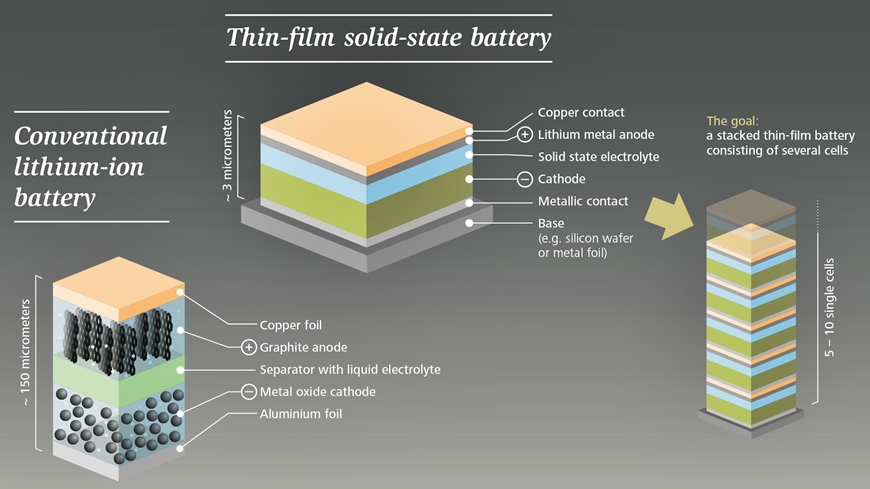
Yaroslav Romanyuk is also proud of his co-workers Moritz Futscher and Abdessalem Aribia, who recently founded the start-up company BTRY (pronounced "battery") – with the aim of developing a lithium-ion solid-state battery to market maturity that takes advantage of the rapid charge transport in thin-film batteries. "The problem with this technology is that such batteries only have a small capacity," explains Romanyuk. "Our idea is: We stack at least ten individual cells on top of each other and get powerful batteries that can be charged and discharged in an extremely short time." What's more, such elements are more robust than current products and safer because they are not flammable (see graphic).
Admittedly, many steps are still needed to develop this technology, which has already been patented, to the point where it is ready for practical use. The specialists are currently working on a lab-scale prototype and are already looking for investors for further development, which could one day also be worthwhile in applications for sophisticated technologies such as aviation. Although, due to the complex manufacturing process, the cost of such batteries will be significantly higher than that of current products, Romanyuk still sees great potential. "For an iWatch, we calculated that our battery would increase the final price tag by about five percent," he explains, "but for a charging time of less than a minute, that could very well be attractive to consumers, couldn't it?"
Diverse technologies, exciting projects, ambitious goals: This means a lot of coordination, lots of mails and contacts, always new research proposals – more management than before and a rigorous workload, also physically. He already acquired the necessary stamina for his very first job in research: a 10-percent stint in the third year of his studies at the Volyn National University in Ukraine.
"My job was to control a furnace for semiconductor crystals at night and set the temperature correctly," Romanyuk recounts, "this meant: waking up every hour, all night long, alone in this huge building!" Conditions that would be unthinkable today – thanks to modern equipment, such as in Empa's Coating Competence Center (see infobox), where thin layers, for example for contacts of thin-film solar cells or batteries, are produced around the clock every day. This is also a cost factor due to the time and energy required.
Empa's Coating Competence Center
Closing the gap between laboratory research and industrial production for coatings: That is the goal of Empa's Coating Competence Center (CCC for short), which went into operation in 2016. A wide range of technologies are available there for the production of printed electronics, solar cells, thin-film batteries and other elements. These include state-of-the-art 3D printers for additive manufacturing (AM) and equipment for curing layers on substrates with light pulses from xenon flash lamps. Of great importance is so-called magnetron sputtering. In this process, a plasma is generated in vacuum chambers using the noble gas argon, which dislodges atoms from a target, which are then deposited in a targeted manner on the desired substrate. Such layers typically reach a thickness between 10 nanometers and 10 micrometers. With its diverse capabilities, the CCC is structured as a private-public partnership. The idea is for the partners involved to work together along the value chain from science to industry to develop new technologies and find creative solutions.
Digital twins as helpers
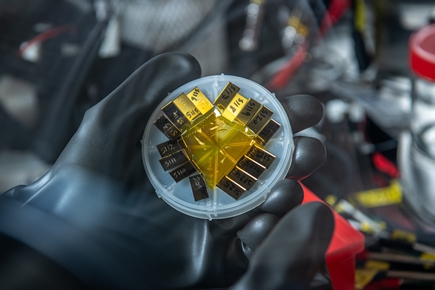
In the future, this work will become ever more efficient: "We will use machine learning and artificial intelligence," says Romanyuk. One example? Developing digital twins of batteries or solar cells before they are actually manufactured. Such virtual models could be used to predict material properties – and that, in turn, could reduce the number of production cycles needed in a vacuum, thus saving time and energy. "Today, it can take up to a week to manufacture a batch of thin-film batteries," Romanyuk explains. "At Empa, we're the record holders in vacuum, so to speak."
His compensation? Fresh air! Swimming, running, or riding his bike six kilometers to work. And at the nature conservation association at home in Fällanden: Bird watching and counting, building stork nests and nesting boxes, also with his two sons, Marco and Taras, 3 and 14 years old. Romanyuk shows the younger one in a happy photo in the garden – but shortly after the snapshot he reached into a wasp nest and was punished with a sting. "That's when daddy wasn't paying attention for a second," says the chemist with a smile: a prick, painful, yes, but no drama – and a first experience in the matter of great curiosity aka the spirit of research.
Dr. Yaroslav Romanyuk
Thin Films and Photovoltaics
Phone +41 58 765 4169
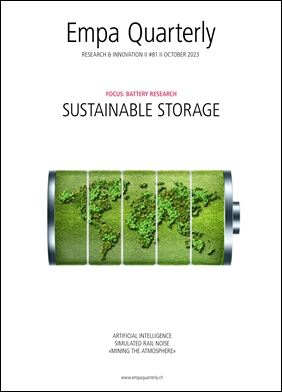
Empa Quarterly#81 Battery research
Being able to store energy is a central pillar of a sustainable energy system, since solar and wind energy are not always available in sufficient quantities when they are needed. Good batteries are indispensable for the energy transition, and thus for a more sustainable world. Empa researchers are developing batteries for different applications, from stationary energy storage to electromobility. They are also working on analyzing and recycling end-of-life batteries.
Read the latest EmpaQuarterly online or download the pdf-version.
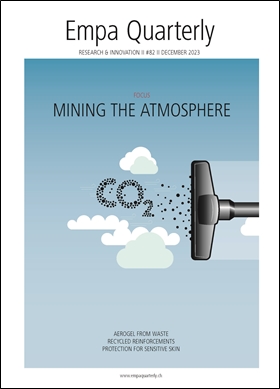
Empa Quarterly#82 Mining the Atmosphere
To limit climate change, we need to compensate not only for future emissions, but also for historical ones. One solution would be the "atmospheric vacuum cleaner": we remove the excess CO2 from the atmosphere. But what do we do with it? Instead of extracting the carbon for polymers, medicines, fibers, fuels and the like from crude oil, we use atmospheric CO2. This is the simple – yet extremely challenging in technical terms – idea behind Empa's new research initiative, Mining the Atmosphere.
Read the EmpaQuarterly online or download the pdf-version.
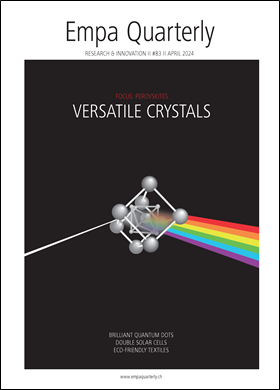
Empa Quarterly#83 Perovskites: Versatile cristals
Over 180 years ago, a curious crystal was discovered in the Ural Mountains. Today, it has given rise to an entire class of materials that is of great interest to researchers: perovskites. What all perovskites have in common is their crystal structure, which gives them unusual properties. By changing the exact composition of the perovskite, scientists can control these properties. Empa researchers are using this promising material to develop solar cells, detectors and quantum dots.
Read the EmpaQuarterly online or download the pdf-version.
-
Share






